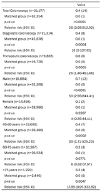Abstract
Background/Aims
Despite the many reports of colonoscopy complications worldwide, few studies have been performed at the population level in Korea. In this study, a population-based study was performed to evaluate the incidence of post-colonoscopy perforations compared to a control group.
Methods
Between January 2011 and December 2011, data for all cases (age over 45) who underwent a colonoscopy were collected from National Health Insurance Service using a random sampling method. The clinical characteristics and perforation incidence (within 30 days after the colonoscopy) of cases were identified, and cases were then compared with controls who had not undergone a colonoscopy.
Results
Among 1,380,000 subjects, 31,177 cases and 62,354 controls were identified. Perforation occurred in 14 patients (0.04%) in the case group and one patient (<0.01%) in the control group (RR, 28.0; 95% CI 3.7–212.9, p<0.001). Subgroup analysis was followed according to the endoscopic procedure, gender and age. In subgroup analysis, colonoscopy-associated perforations occurred more in the therapeutic procedure (RR, 26; 95% CI 1.46–461.46), male (RR, 50; 95% CI 2.96–844.41), and age of 45–60 years (RR, 30; 95% CI 1.71–525.23).
Figures and Tables
Notes
References
1. Cancer registration statistics from National Cancer Center (2015). [Internet]. Goyang: National Cancer Center;2017. 12. 29. cited 2018 Oct 8. Available from: http://ncc.re.kr/cancerStatsView.ncc?bbsnum=418&searchKey=total&searchValue=&pageNum=1.
2. Pox CP, Altenhofen L, Brenner H, Theilmeier A, Von Stillfried D, Schmiegel W. Efficacy of a nationwide screening colonoscopy program for colorectal cancer. Gastroenterology. 2012; 142:1460–1467.e2.


3. Jung KW, Park S, Kong HJ, et al. Cancer statistics in Korea: incidence, mortality, survival, and prevalence in 2008. Cancer Res Treat. 2011; 43:1–11.



4. ASGE Standards of Practice Committee. Fisher DA, Maple JT, et al. Complications of colonoscopy. Gastrointest Endosc. 2011; 74:745–752.


5. Sohn DK, Kim MJ, Park Y, et al. The Korean guideline for colorectal cancer screening. J Korean Med Assoc. 2015; 58:420–432.
6. Zwink N, Holleczek B, Stegmaier C, Hoffmeister M, Brenner H. Complication rates in colonoscopy screening for cancer. Dtsch Arztebl Int. 2017; 114:321–327.



7. Wang L, Mannalithara A, Singh G, Ladabaum U. Low rates of gastrointestinal and non-gastrointestinal complications for screening or surveillance colonoscopies in a population-based study. Gastroenterology. 2018; 154:540–555.

8. Warren JL, Klabunde CN, Mariotto AB, et al. Adverse events after outpatient colonoscopy in the medicare population. Ann Intern Med. 2009; 150:849–857. W152.


9. Blotière PO, Weill A, Ricordeau P, Alla F, Allemand H. Perforations and haemorrhages after colonoscopy in 2010: a study based on comprehensive French health insurance data (SNIIRAM). Clin Res Hepatol Gastroenterol. 2014; 38:112–117.


10. Sieg A, Hachmoeller-Eisenbach U, Eisenbach T. Prospective evaluation of complications in outpatient GI endoscopy: a survey among German gastroenterologists. Gastrointest Endosc. 2001; 53:620–627.


11. Zafar HM, Harhay MO, Yang J, Armstron K. Adverse events following computed tomographic colonography compared to optical colonoscopy in the elderly. Prev Med Rep. 2014; 1:3–8.



12. Moon HS, Park SW, Kim DH, Kang SH, Sung JK, Jeong HY. Only the size of resected polyps is an independent risk factor for delayed postpolypectomy hemorrhage: a 10-year single-center case-control study. Ann Coloproctol. 2014; 30:182–185.



13. Kim HS, Kim TI, Kim WH, et al. Risk factors for immediate postpolypectomy bleeding of the colon: a multicenter study. Am J Gastroenterol. 2006; 101:1333–1341.


14. Rabeneck L, Paszat LF, Hilsden RJ, et al. Bleeding and perforation after outpatient colonoscopy and their risk factors in usual clinical practice. Gastroenterology. 2008; 135:1899–1906.


15. Arora G, Mannalithara A, Singh G, Gerson LB, Triadafilopoulos G. Risk of perforation from a colonoscopy in adults: a large population-based study. Gastrointest Endosc. 2009; 69(3 Pt 2):654–664.


16. Levin TR, Zhao W, Conell C, et al. Complications of colonoscopy in an integrated health care delivery system. Ann Intern Med. 2006; 145:880–886.


17. Kim JH, Jeon EJ, Song JH, et al. Colonoscopic perforation during a diagnostic colonoscopy. Korean J Gastrointest Endosc. 2011; 42:289–292.
18. Suh JH, Kim CS, Lee KC, Ko JC. Colonoscopic perforations: 4 years’ experience. Korean J Gastrointest Endosc. 2009; 38:9–13.
19. Kang HY, Kang HW, Kim SG, et al. Incidence and management of colonoscopic perforations in Korea. Digestion. 2008; 78:218–223.


20. Panteris V, Haringsma J, Kuipers EJ. Colonoscopy perforation rate, mechanisms and outcome: from diagnostic to therapeutic colonoscopy. Endoscopy. 2009; 41:941–951.

21. Kim YS, Lee DS, Jung JJ, et al. Complication of colonoscopic polypectomy. Korean J Gastrointest Endosc. 2000; 21:917–923.
22. Wadas DD, Sanowski RA. Complications of the hot biopsy forceps technique. Gastrointest Endosc. 1988; 34:32–37.


23. Damore LJ 2nd, Rantis PC, Vernava AM 3rd, Longo WE. Colonoscopic perforations. Etiology, diagnosis, and management. Dis Colon Rectum. 1996; 39:1308–1314.

24. Nelson DB, McQuaid KR, Bond JH, Lieberman DA, Weiss DG, Johnston TK. Procedural success and complications of large-scale screening colonoscopy. Gastrointest Endosc. 2002; 55:307–314.


25. Kavin H, Sinicrope F, Esker AH. Management of perforation of the colon at colonoscopy. Am J Gastroenterol. 1992; 87:161–167.

26. Chino A, Karasawa T, Uragami N, Endo Y, Takahashi H, Fujita R. A comparison of depth of tissue injury caused by different modes of electrosurgical current in a pig colon model. Gastrointest Endosc. 2004; 59:374–379.


27. Savides TJ, See JA, Jensen DM, Jutabha R, Machicado GA, Hirabayashi K. Randomized controlled study of injury in the canine right colon from simultaneous biopsy and coagulation with different hot biopsy forceps. Gastrointest Endosc. 1995; 42:573–578.


28. Carpenter S, Petersen BT, Chuttani R, et al. Polypectomy devices. Gastrointest Endosc. 2007; 65:741–749.


29. Rabeneck L, Saskin R, Paszat LF. Onset and clinical course of bleeding and perforation after outpatient colonoscopy: a population-based study. Gastrointest Endosc. 2011; 73:520–523.






 PDF
PDF ePub
ePub Citation
Citation Print
Print






 XML Download
XML Download